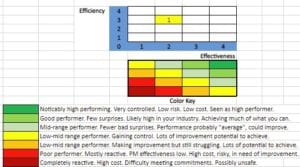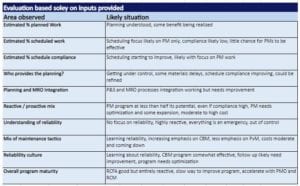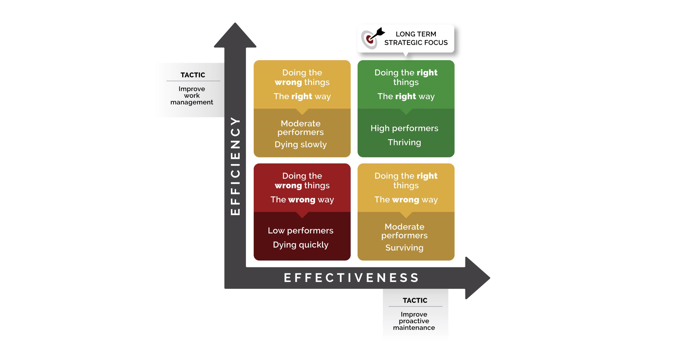Our business case estimator insights show you both savings and earnings potential for improvements in maintenance and reliability. If you are reading this, you probably think there is some opportunity to improve your operational reliability and maintenance performance. You might want to create a business case for change that you can use to get senior management approval and funding. You are in the right place. We’ve created the tools for you to do that, they are readily accessible and inexpensive (the first step is even free). After a period of isolation and/or skeleton staffing, you can probably see problems that may be more hidden when operating with a full staff. Now is a good time to address those to bring performance up as a part of your “new normal”.
Our book, “Paying Your Way – Improving Performance through Uptime”, by James Reyes-Picknell, may become your best friend real soon.
If you are in charge of maintenance, reliability, or asset management, you probably have very little spending authority, yet you may realize that you are sitting on a lot of money if you can make the improvements that are necessary to achieve high performance. Your general managers, VP finance, and executive-level operations and finance officers will want a solid business case. You now have the tools to provide that for them without the need for a lot of expensive consulting assessments and effort. You only need to answer some questions honestly and get some meaningful inputs about current performance and related financials. You can probably approve the costs of using the tools and with the result, or easily get the needed approval.
First, we’ve added a “Maintenance and Reliability Maturity Assessment” tool to our website. It asks ten questions, some of which require numeric ranges for metrics, to arrive at a rough maturity assessment on the scales of Efficiency (mostly maintenance work and related activities execution) and Effectiveness (mostly reliability program-related). Efficiency is all about how well you can get your work done, while effectiveness is about ensuring you are doing the right work.
You can be very efficient doing the wrong work and gain little for it, although your maintenance department metrics may actually look pretty good. If you have a very good maintenance program (highly effective) it will be hobbled by inefficient execution. You need both to maximize your benefits.
If you’ve been following our blog, you have probably seen the graphic above before. Those blog articles explain the concepts in more detail. You want to be in the upper right corner of that plot.
A highly reliable operation will be cheaper to maintain and operate than one that is unreliable. By how much? Well, that is what our Business Case Estimator Insights provide. In your assets, it means fewer breakdowns so you require fewer repairs. To achieve that you need a really good proactive maintenance program with the right mix of preventive, predictive, detective, and run-to-failure. The latter is only permitted when you can actually tolerate the failures with minimal consequence to the business. Determining that requires an analytical approach – Reliability Centered Maintenance is the best. You might balk at the costs and effort to do RCM, but the payback can be immense.
An efficient organization will plot near the top of the grid. An effective one will plot near to the right. If both, you are in the green zone doing the right things the right way and reaping the benefits. Green is where you want to be!
If you take the online assessment, your results may look something like this:
 Your responses will put you in a colored box shown in the top segment. Below it is a graphic to show the colors of all the boxes so you can see how you “rank” relative in the assessment. Below that is a key with very generalized descriptions. They may or may not fit closely, but bear in mind that they are not industry-specific, and they are very sensitive to the answers you provided in the self-assessment.
Your responses will put you in a colored box shown in the top segment. Below it is a graphic to show the colors of all the boxes so you can see how you “rank” relative in the assessment. Below that is a key with very generalized descriptions. They may or may not fit closely, but bear in mind that they are not industry-specific, and they are very sensitive to the answers you provided in the self-assessment.
This free assessment will give you a rough idea of whether or not you should investigate further. If your responses land you in the red, orange, or yellow boxes, then you really need to dig deeper into what it is that you can do better. A tiny investment now might reveal massive potential, especially if you are in the red or close to it. On the other hand, if you are in the green zone, then you are already doing reasonably well, but unless you are in the dark green box, you will still have room to improve.
In the example shown, the rating is yellow. The description is, “low to the mid-range performer. Gaining control. Lots of improvement potential to achieve”. Doesn’t say much about “how much” but at least you know you have a way to go. For that, you need our Business Case Estimator.
It starts with the same maturity assessment. Unfortunately, since we don’t save your responses and data, the answers from the Maturity Assessment don’t carry over to the Estimator, but you can save a copy of your assessment and copy the answer over easily.
Out business case estimator insights go quite a bit further. You then enter some performance and financial data that is used, together with some estimates created from your assessment responses, to generate a forecast of future performance improvement potential. For a larger operation having the answers to produce the yellow box above, having $1.5 billion in replacement asset value (i.e.: the cost to replace all the assets with today’s capacity), and a maintenance budget of around $90 million, here is the potential gain:
 As you can see the savings in maintenance costs alone are substantial, nearly $32 million. Yes, about a third of the budget. Seems high? It should. Work efficiency has room for improvement, as does coordination of planning with MRO spares. The effectiveness of the maintenance program is actually on the low end of the range, so this organization isn’t getting much benefit from its proactive maintenance program.
As you can see the savings in maintenance costs alone are substantial, nearly $32 million. Yes, about a third of the budget. Seems high? It should. Work efficiency has room for improvement, as does coordination of planning with MRO spares. The effectiveness of the maintenance program is actually on the low end of the range, so this organization isn’t getting much benefit from its proactive maintenance program.
You will get some useful financial forecasts for the improvements as well. Improvements to production, margin, and profit as well as your use of working capital. Your General Management, Financial and Executive leadership will be very interested in these. Unless you are doing things totally right today, there is probably a lot of money on the table and it’s relatively inexpensive to get it, with the right program for improvements. Chances are that Covid-19 imposed work and cost restrictions that have probably harmed reliability. It’s not too late to get that back or to improve it, but short-term savings will surely result in long-term pain!
You probably want to know what to do about it. Another output of the estimator is a table of remarks about the present state that gives a pretty good idea of where improvements are needed and how the situation today is probably presented in real life.
 Those are all automated, general statements that are sensitive to the answers that you provided in the self-assessment of maturity. They are statements based on our experience in seeing hundreds of sites at various possible states (combinations) of maturity and performance.
Those are all automated, general statements that are sensitive to the answers that you provided in the self-assessment of maturity. They are statements based on our experience in seeing hundreds of sites at various possible states (combinations) of maturity and performance.
Your personnel probably don’t connect the current situation (i.e.: the symptoms they see daily) with the root of the problems and what to do about them. These statements are feedback based on rules we have input to the modeling tool. The rules are a result of our experience with hundreds of organizations, seeing what they do well, what they do poorly, and seeing how it appears on the surface. It is a simple form of rules-based artificial intelligence based on a lot of experience.
If your inputs are inaccurate or misleading, then it will give misleading results.
When doing the self-assessment, pay particular attention to the definitions we’ve provided, particularly for what is planned and what is scheduled. Those are often misunderstood, so whether or not you agree with our definition isn’t the point – the model is based on those definitions and if you disagree, and then use your own definition, you will get misleading outputs. Use our definitions. You may need to dig a bit to get accurate inputs, but it will be work that is well worth the effort. If your data is lacking, then make estimates. One word of advice if estimating. Your numbers are probably in the lower performance end of the range if you can’t find them easily.
The Estimator can show you what improvements will produce for the business, but it won’t tell you how. For that, we need to get involved with you. There’s no way we could provide that sort of recommendation without understanding what’s going on at your operations. Keep in mind, this is an Estimator, not an artificial consultant. Click here to schedule an appointment so we can talk about what you can do to realize the benefits that are estimated.
If there is any doubt about your inputs or the outputs and how to interpret them, then we are available for consultation to examine your inputs and results more closely, then have a discussion by phone or online about it. .
The Business Case Estimator involves complex calculations based on your inputs. After you use it, download it. It will include your inputs and results. That file is yours. We do not keep a copy of your data, so for discussion purposes, we advise you to save it. When you are ready, you can upload it so we will be able to view it.


